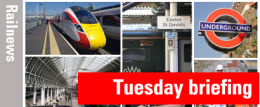Posted 22nd February 2022 | 2 Comments
Rail Delivery Group calls for railfreight volumes to treble

The Rail Delivery Group says there should be a target of trebling rail freight in England and Wales by 2050, so that rail is 'the backbone' of a sustainable zero-carbon transport network. The RDG has made its call in a submission on behalf of independent passenger and freight operators to the rail industry’s thirty-year Whole Industry Strategic Plan. The RDG says it has 'made it clear' that there is a strong long-term demand for rail freight services. The amount of supermarket traffic carried by train has been increasing recently, fuelled in part by the shortage of HGV drivers.
The RDG says trebling the freight target by 2050 would mean 21 million fewer HGV journeys a year or 400,000 fewer a week. A trebling of freight volumes would also mean avoiding 4.2 million tonnes of Co2 emissions every year. Meeting the new target will require a 4 per cent annual increase and around 22 per cent over the next five years alone. By comparison Transport Scotland’s target for 2019-2024 is 7.5 per cent, which is around 1.5 per cent a year.
RDG director general Andy Bagnall said: 'Rail freight is already playing a crucial role in supporting economic growth as we come out of the pandemic. But it can do so much more. So we are calling for a new target of trebling of rail freight by 2050, taking HGVs off the road, supporting the UK economy, while improving congestion and air quality.'
Storm clear-up continues
Repairs to damage caused to the railway by three storms over the past few days are continuing. Flooding in the north of England has affected railways in a number of places, and Rotherham Central is still closed at the moment because water from the nearby River Don has submerged the tracks, while flooding has also blocked the lines at Shrewsbury. High winds from Storm Franklin closed the Great Eastern Main Line yesterday, when a tree was blown on to the overhead wires near Chelmsford. National Rail is predicting a normal service on most routes today, but the operators still affected by the effects of the storms at 09.30 today were Govia Thameslink Railway, TransPennine Express, Transport for Wales and West Midlands Railway.
'Hong Kong style' financing should be considered, says TfN chair
Funding for Northern Powerhouse Rail could be raised by using 'Hong Kong style' land taxes, and the idea has been described as deserving 'serious consideration' by Lord McLoughlin, the former Conservative transport secretary who now chairs Transport for the North. However, some business leaders are said to be very doubtful about such a tax, which would be levied by taxing land along the route of a new railway, where the landowners should benefit over time from a new link because the value of their land would rise. Patrick McLoughlin has been quoted as saying: 'I think it is something we need to look at to see whether it is a feasible idea. If you see an area has vastly improved because of some investment that Government has put in, then why not say some of that money should also come back to the taxpayer? That is something that could be looked at. I think some people would say it is a pity that wasn’t argued earlier on and it is a bit after the event. I can’t change what’s happened and what’s gone on. I can say, let’s look at it and see if there is a realistic opportunity of doing it.' He added: 'You talk to some business leaders and they are very sceptical about it. It isn’t straightforward but certainly we should do some work on it and look at where it has worked elsewhere.'
Reader Comments:
Views expressed in submitted comments are that of the author, and not necessarily shared by Railnews.

david c smith, Bletchley
One area of freight traffic that is not well catered to is "piggyback" semitrailer on train. Many warehouses and factoriees are configured to handle semitrailers rather than ISO containers. The obvious rejection re such traffic in GB is our restrictive loading guages ; however back in 1990 / 91,there was a short lived traffic between Melton Mowbray and London / Manchester under the name "Charterail" . It came to an end due , I understand, to dispute between this company and BR (who provided haulage).
Charterail used low profile semitrailers to deal with loading guage problems. but otherwise, the semitrailers did not need special strengthening, as they did not need any lifting by crane, etc. but were backed onto the rail wagon using a special rotatable floor.
Similar current examples of this type of technology are " Modalohr" (French) and "Cargobeamer" (German). Additionally, some trunk freight routes in GB have more recently had loading guage enhancement to be able to take 9 ft 6ins cotainers. Perhaps another contribution to the tripling mentined above ?
ISO container traffic to / from ports has been a big success for our railfreight operators. Could similar success happen for "inland" freight, including via the Channel Tunnel?
Tony Pearce, Reading
I once worked for a Company (many years ago) where most of the output was transported by rail. We even had little Hornby Dublo Models of our Wagons to give away to customers who a Model Railway. But even back then our product was very time critical and we couldn't have any strikes - or threat of strikes - threatening our deliveries. So we switched to road and used several Road Hauliers to transport our Goods. The problem for firm still remains because the RMT always have high profile strike threats even if they are not used. Any freight moved from Road to Rail would need the ability to switch back again quickly. Trust is difficult to build and easy to destroy.